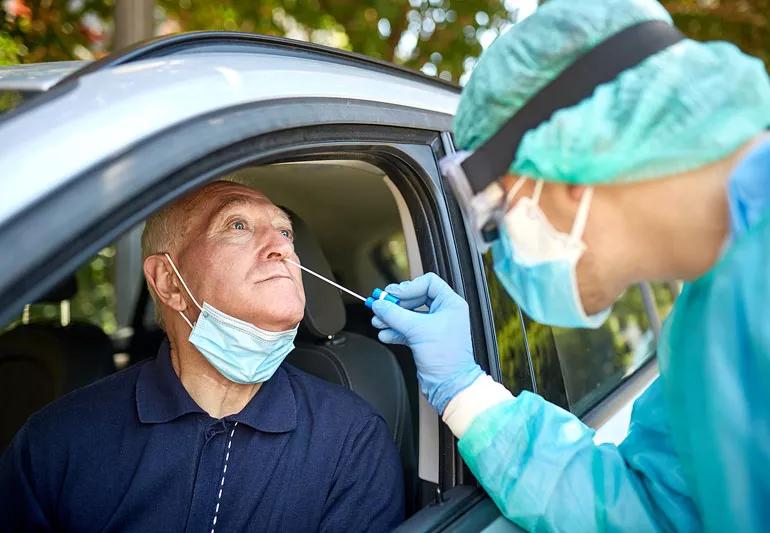Phone triage system reduces call backs and delays in care

For high-volume primary care practices, delays in response for symptom-based telephone calls can result in delays in care and patient frustration. Cleveland Clinic Willoughby Hills Family Health Center (FHC), which provides adult and pediatric primary care, launched a project to address the issue.
Advertisement
Cleveland Clinic is a non-profit academic medical center. Advertising on our site helps support our mission. We do not endorse non-Cleveland Clinic products or services. Policy
“Patients were making multiple calls per day to the facility just to talk to a nurse about a medical problem,” says Cyndi Baird, BSN, RN, CMSRN, who is an RN team lead for primary care at the family health center. “Our goal was to decrease calls to the facility by giving patients a designated time they could expect a call back from a nurse so we avoid playing phone tag.”
Nurses at Willoughby Hills FHC implemented a nurse triage schedule that has reduced nursing pool messages by an average of 100 patient symptom-based calls per week.
The inspiration for a nurse triage schedule began with the COVID pandemic when the family health center was flooded with symptom-based calls.
“We began doing pop-up scheduling for COVID testing,” says Renelle Bouffard, BSN, RN, who was a nurse manager at Willoughby Hills FHC during that time. “One of the nursing directors and I wondered if we could use pop-up scheduling to find time for patients to talk to nurses.”
Bouffard, the regional nursing director of ambulatory operations and clerical teams from various family health centers began brainstorming ways to get first-call resolution and avoid delays in patient care.
“As an ambulatory nurse, your first responsibility is to rule out priority symptoms and figure out where patients need to go,” says Bouffard, who now serves as Cleveland Clinic’s director of ambulatory operations, east market. “We discovered, unfortunately, that some patients who need attention sooner were waiting for call backs.”
The team created a flow chart for patient calls. If a patient has symptom-based questions, the family health center operator ascertains if the symptoms are urgent using a list of key words. For instance, patients complaining of chest pain, shortness of breath, loss of vision, severe abdominal pain and other emergent symptoms are immediately routed to the primary care provider hotline.
Advertisement
“Patients who report any nonemergent symptom that don’t require speaking to a nurse right away are placed on our triage schedule,” says Baird.
Willoughby Hills FHC has two designated nurses working triage in four-hour blocks, eight hours a day Monday through Friday. Patient call backs are scheduled every 20 minutes. If the patient doesn’t answer the first call, then nurses try again a total of three times with five minutes between each call. If the patient still hasn’t answered the call, then the triage encounter is transferred to the nurse pool for follow-up. Only 3% of first calls are not answered.
The family health center calls the process “one-click nurse triage” because the operator simply double clicks an appointment slot in Epic to add the patient to the triage schedule.
“They add in appointment notes, the patient call-back number and what the symptoms are. We instruct the patient that a nurse will call them at a specific time, and they don’t need to call us back,” says Bouffard. “We worked very hard to develop clear scripting and make it easy for staff.”
All adult and pediatric primary care nurses rotate on the triage schedule. “It was an adjustment at first for our nurses, but they were trained on the process and protocols and now it’s an everyday practice,” says Bouffard. “The schedule allows nurses to focus on one task for those four hours. It’s their priority.”
The family health center has real-time control to adapt the schedule based on staffing. It can designate only one nurse on the triage schedule or reduce call blocks, if necessary, though it has rarely done so.
Advertisement
“One-click nurse triage is a patient satisfier,” says Baird. “Patients aren’t anxiously waiting around wondering if they should bring their sick child to the doctor or go to the emergency room.”
Triage nurses are calling an average of 25 patients per day since the program launched in May 2021. They have consulted on a variety of topics, from canker sores and back pain to medication and office visit follow-up questions. The goal is to return all symptom-based calls within two to four hours.
One-click nurse triage has also allowed the family health center to better match patients to care, scheduling those who need it in open physician appointments.
“We have increased our slot utilization, making better use of our providers’ time so we are not delaying care,” says Bouffard.
Willoughby Hills FHC has also achieved another primary goal – decreasing patient call backs. The month before implementing one-click nurse triage, the facility had 1,054 incoming calls. Two months later, it had 663 calls.
“It shouldn’t be so hard to call in and talk to your doctor’s office. First-call resolution – getting patients where they need to be and not leaving them wondering about their care – builds trust,” says Bouffard. “The one-click nurse triage schedule is an example of our nurses in action, building a best practice for ambulatory care.”
Advertisement
Advertisement

An unexpected health scare provides a potent reminder of what patients need most from their caregivers

Cleveland Clinic Abu Dhabi initiative reduces ICU admissions and strengthens caregiver collaboration

Veteran nurse blends compassion, cutting-edge transplant training and military tradition to elevate patient care

Embrace coaching and other tips to be a stronger leader

Compassion, communication and critical thinking are key

How hospitals can weave ethics into daily nursing practice to strengthen patient-centered care

Guiding nurses amid a constantly evolving healthcare landscape

Ideation session generates solutions to medication administration errors